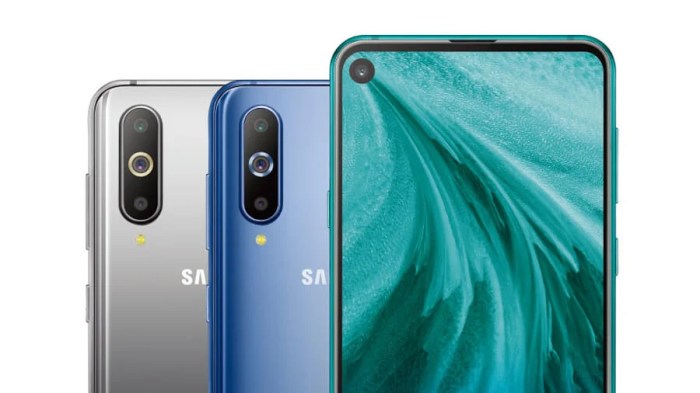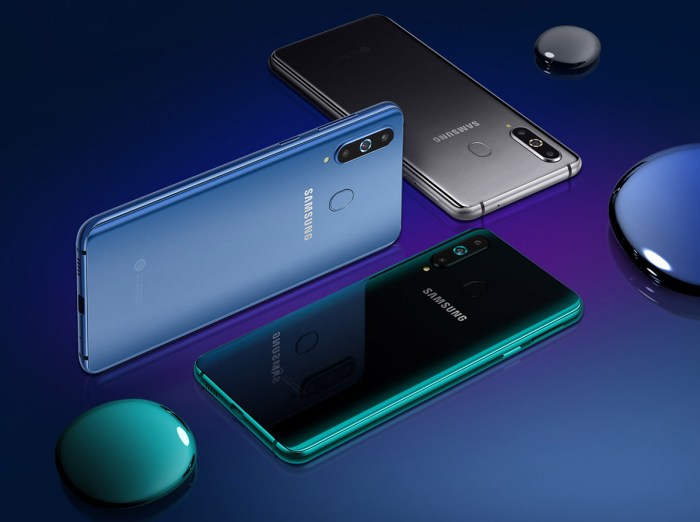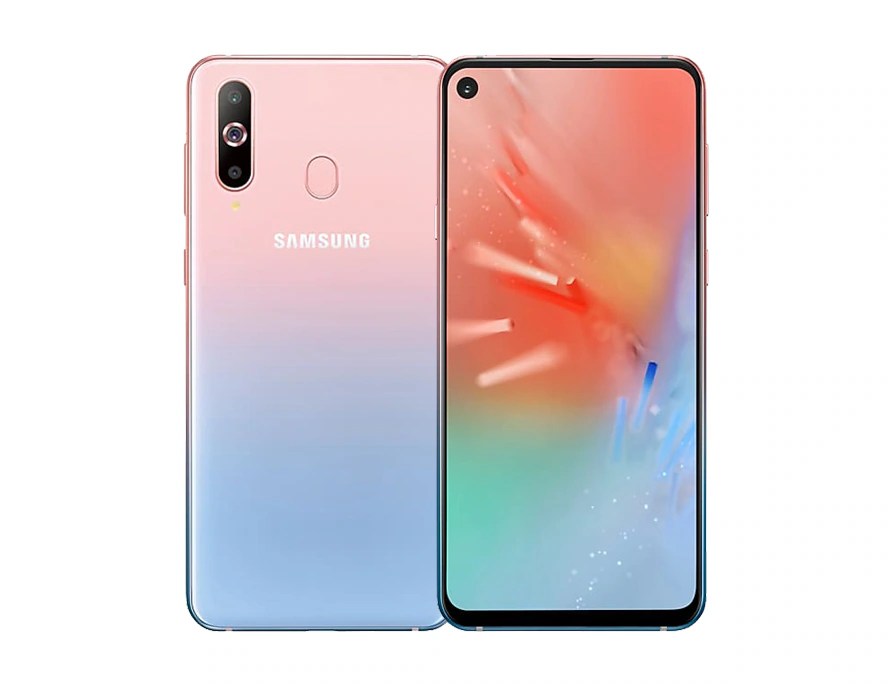Samsung Galaxy A8s Specification and Price
Samsung Galaxy A8s: A Deep Dive into Specifications, Price, and Market Impact
Samsung galaxy a8s specification and price – The Samsung Galaxy A8s, launched in late 2018, marked a significant step for Samsung in the mid-range smartphone market. It was one of the first phones to feature the innovative Infinity-O display, a design element that would influence many subsequent smartphone releases. This analysis explores the device’s specifications, pricing, market positioning, and lasting impact.
Introduction to Samsung Galaxy A8s

Source: noypigeeks.com
The Galaxy A8s targeted the tech-savvy consumer seeking a premium design and features at a competitive price point. It aimed to bridge the gap between Samsung’s mid-range and flagship offerings. Key features at launch included the groundbreaking Infinity-O display, a triple-camera system, and a powerful processor for smooth performance. The phone was initially released in December 2018, with pricing varying across regions, reflecting local market conditions and import duties.
Finding details on the Samsung Galaxy A8s specification and price often leads to comparisons with similar models. For instance, understanding the pricing and features of the Samsung Galaxy A7 2018, particularly in India, can provide helpful context; you can check the specifics here: samsung galaxy a7 2018 specification and price in india. This comparison helps illustrate the differences and similarities in Samsung’s mid-range offerings, ultimately informing your decision regarding the Samsung Galaxy A8s specification and price.
Detailed Specifications of Samsung Galaxy A8s

Source: wccftech.com
The Galaxy A8s boasted impressive specifications for its price bracket. The following table summarizes its key features:
| Specification | Detail |
|---|---|
| Processor | Qualcomm Snapdragon 710 |
| RAM | 6GB/8GB |
| Storage | 128GB |
| Display | 6.4-inch Infinity-O Super AMOLED |
| Camera (Rear) | 24MP Main, 10MP Telephoto, 5MP Depth Sensor |
| Camera (Front) | 24MP |
| Battery | 3400mAh |
| Operating System | Android 9.0 (Pie) |
The Infinity-O display was a significant technological advancement, featuring a near bezel-less design with a hole-punch cutout for the front-facing camera. This innovative approach maximized screen real estate while maintaining a sleek aesthetic, setting a trend for future smartphone designs. The triple-camera system offered versatile photography capabilities, though its performance was comparable to, rather than exceeding, other contemporary mid-range devices from competitors like Xiaomi and Oppo.
Price Analysis of Samsung Galaxy A8s Across Regions
The initial launch price of the Samsung Galaxy A8s varied significantly across different regions. This price disparity was influenced by factors such as import tariffs, taxes, local market competition, and currency exchange rates.
| Region | Launch Price (USD Equivalent – Approximate) |
|---|---|
| China | $350 – $400 |
| Europe | $400 – $450 |
| Other Asian Markets | $380 – $430 |
Over time, the price of the Galaxy A8s fluctuated based on market demand and the launch of competing models. As newer devices entered the market, the price of the A8s typically decreased.
Comparison with Competitors at Launch
At launch, the Galaxy A8s competed with devices like the Xiaomi Mi 8 and the Oppo R17 Pro. A key differentiator was its innovative Infinity-O display. However, in terms of raw processing power and camera capabilities, it was generally comparable to, not superior to, its competitors.
- Xiaomi Mi 8: Offered similar processing power and camera features, but lacked the unique Infinity-O display.
- Oppo R17 Pro: Featured superior camera technology, particularly in low-light conditions, but at a higher price point.
The Galaxy A8s’ unique selling proposition was its blend of premium design elements, particularly the Infinity-O display, and a competitive price point within the mid-range segment.
Samsung Galaxy A8s Legacy and Impact, Samsung galaxy a8s specification and price
The Galaxy A8s had a moderate impact on the market. While not a massive commercial success, it played a significant role in Samsung’s product strategy. The phone helped establish the Infinity-O display design as a viable option for mid-range devices, paving the way for its adoption in subsequent Samsung models. Early user reviews were generally positive, praising the display and design, while some criticized the camera performance in certain conditions.
The phone’s legacy lies in its contribution to the evolution of smartphone design and its role in Samsung’s ongoing efforts to offer innovative features at various price points.
Visual Representation of Key Features

Source: samsung.com
The Galaxy A8s featured a sleek, modern design. Its dimensions and weight were optimized for comfortable one-handed use. The phone’s most striking feature was its 6.4-inch Infinity-O Super AMOLED display, which dominated the front face, with a small, discreet punch-hole cutout housing the front-facing camera in the top-left corner. The rear housed a triple-camera system arranged vertically in a stylish module.
The phone was available in various color options, including black, blue, and green. The user interface was typical of Samsung’s One UI, offering a clean, intuitive experience with easy navigation through a combination of gestures and on-screen buttons.
FAQ Explained: Samsung Galaxy A8s Specification And Price
Did the Samsung Galaxy A8s receive any major software updates after its initial release?
Yes, it received several software updates, including security patches and some feature enhancements, though the extent varied by region.
How does the Galaxy A8s’ battery life compare to its competitors?
Battery life was generally considered average for its class, performing adequately for daily use but not exceptional. Actual performance varied depending on usage patterns.
Were there any significant manufacturing defects reported for the Samsung Galaxy A8s?
While not widespread, some users reported minor issues like screen discoloration or occasional software glitches. These were not widespread enough to be considered major manufacturing defects.





















